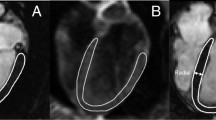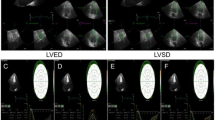Abstract
Aims
Postsystolic wall thickening (PSWT) occurs after aortic valve closure. We investigated the influence of ischemia location and wall interactions on PSWT in normal and stunned myocardium.
Methods and results
Twenty-two dogs were studied. Seven chronically instrumented dogs (sonomicrometry) underwent 10-min coronary artery occlusion (CAO) of left circumflex artery (“LCX stunning”) and seven other dogs underwent 10-min CAO of the anterior descending artery (“LAD stunning”) followed by reperfusion. At baseline, there was no PSWT in the anterior wall whereas posterior wall started and finished to thicken after the anterior wall, demonstrating PSWT. With LCX stunning, PSWT was observed in the posterior wall without affecting the remote anterior wall. With LAD stunning, PSWT in the anterior wall was transient and of lower magnitude Vs. posterior wall; in the remote posterior wall, PSWT previously observed at baseline, almost vanished. Postsystolic to systolic wall thickening ratio identified (ROC analysis) normal, ischemic and stunned myocardium with different amplitudes between walls. Tissue Doppler Imaging demonstrated similar pattern in basal, mid and apical segments (additional n = 4 for both LCX and LAD stunning).
Conclusion
The present study demonstrates that location of ischemia and wall interactions produce discrepancies in PSWT between anterior and posterior walls in stunned myocardium.








Similar content being viewed by others
References
Birkeland S, Hexeberg E (1994) Is postsystolic shortening area always a marker of myocardial ischaemia? Acta Physiol Scand 151:269–277
Brown MA, Norris RM, Takayama M, White HD (1987) Post-systolic shortening: a marker of potential for early recovery of acutely ischaemic myocardium in the dog. Cardiovasc Res 21:703–716
Citro R, Galderisi M (2005) Myocardial postsystolic motion in ischemic and not ischemic myocardium: the clinical value of tissue Doppler. Echocardiography 22:525–532
Derumeaux G, Ovize M, Loufoua J, Pontier G, Andre-Fouet X, Cribier A (2000) Assessment of nonuniformity of transmural myocardial velocities by color-coded tissue Doppler imaging: characterization of normal, ischemic, and stunned myocardium. Circulation 101:1390–1395
Ehring T, Heusch G (1990) Left ventricular asynchrony: an indicator of regional myocardial dysfunction. Am Heart J 120:1047–1057
Ehring T, Heusch G (1991) Postextrasystolic potentiation does not distinguish ischaemic from stunned myocardium. Pflugers Arch 418:453–461
Fan D, Soei LK, Stubenitsky R, Boersma E, Duncker DJ, Verdouw PD, Krams R (1997) Contribution of asynchrony and nonuniformity to mechanical interaction in normal and stunned myocardium. Am J Physiol 273:H2146–H2154
Gaasch WH, Blaustein AS, Bing OH (1985) Asynchronous (segmental early) relaxation of the left ventricle. J Am Coll Cardiol 5:891–897
Guth BD, Schulz R, Heusch G (1990) Evaluation of parameters for the assessment of regional myocardial contractile function during asynchronous left ventricular contraction. Basic Res Cardiol 85:550–562
Heusch G, Guth BD, Widmann T, Peterson KL, Ross J Jr (1987) Ischemic myocardial dysfunction assessed by temporal Fourier transform of regional myocardial wall thickening. Am Heart J 113:116–124
Hoit BD, Lew WY (1988) Functional consequences of acute anterior vs. posterior wall ischemia in canine left ventricles. Am J Physiol 254:H1065–H1073
Hosokawa H, Sheehan FH, Suzuki T (2000) Measurement of postsystolic shortening to assess viability and predict recovery of left ventricular function after acute myocardial infarction. J Am Coll Cardiol 35:1842–1849
Ihara T, Komamura K, Shen YT, Patrick TA, Mirsky I, Shannon RP, Vatner SF (1994) Left ventricular systolic dysfunction precedes diastolic dysfunction during myocardial ischemia in conscious dogs. Am J Physiol 267:H333–H343
Jamal F, Kukulski T, D’Hooge J, De Scheerder I, Sutherland G (1999) Abnormal postsystolic thickening in acutely ischemic myocardium during coronary angioplasty: a velocity, strain, and strain rate doppler myocardial imaging study. J Am Soc Echocardiogr 12:994–996
Jamal F, Kukulski T, Strotmann J, Szilard M, D’Hooge J, Bijnens B, Rademakers F, Hatle L, De Scheerder I, Sutherland GR (2001) Quantification of the spectrum of changes in regional myocardial function during acute ischemia in closed chest pigs: an ultrasonic strain rate and strain study. J Am Soc Echocardiogr 14:874–884
Jamal F, Szilard M, Kukulski T, Liu XS, D’Hooge J, Bijnens B, Rademakers F, Hatle L, Descheerder I, Sutherland GR (2001) Changes in systolic and postsystolic wall thickening during acute coronary occlusion and reperfusion in closed-chest pigs: Implications for the assessment of regional myocardial function. J Am Soc Echocardiogr 14:691–697
Kanaya N, Fujita S (1994) The effects of isoflurane on regional myocardial contractility and metabolism in “stunned” myocardium in acutely instrumented dogs. Anesth Analg 79:447–454
Knight DR, Shen YT, Thomas JX Jr., Randall WC, Vatner SF (1988) Sympathetic activation induces asynchronous contraction in awake dogs with regional denervation. Am J Physiol 255:H358–H365
Kukulski T, Jamal F, Herbots L, D’Hooge J, Bijnens B, Hatle L, De Scheerder I, Sutherland GR (2003) Identification of acutely ischemic myocardium using ultrasonic strain measurements. A clinical study in patients undergoing coronary angioplasty. J Am Coll Cardiol 41:810–819
Kumada T, Gallagher KP, Shirato K, McKown D, Miller M, Kemper WS, White F, Ross J Jr (1980) Reduction of exercise-induced regional myocardial dysfunction by propranolol. Studies in a canine model of chronic coronary artery stenosis. Circ Res 46:190–200
Leclercq C, Faris O, Tunin R, Johnson J, Kato R, Evans F, Spinelli J, Halperin H, McVeigh E, Kass DA (2002) Systolic improvement and mechanical resynchronization does not require electrical synchrony in the dilated failing heart with left bundle-branch block. Circulation 106:1760–1763
Lew WY, Rasmussen CM (1989) Influence of nonuniformity on rate of left ventricular pressure fall in the dog. Am J Physiol 256:H222–H232
Lucats L, Ghaleh B, Monnet X, Colin P, Bize A, Berdeaux A (2007) Conversion of post-systolic wall thickening into ejectional thickening by selective heart rate reduction during myocardial stunning. Eur Heart J 28:872–879
McVeigh ER, Prinzen FW, Wyman BT, Tsitlik JE, Halperin HR, Hunter WC (1998) Imaging asynchronous mechanical activation of the paced heart with tagged MRI. Magn Reson Med 39:507–513
Monnet X, Colin P, Ghaleh B, Hittinger L, Giudicelli JF, Berdeaux A (2004) Heart rate reduction during exercise-induced myocardial ischaemia and stunning. Eur Heart J 25:579–586
Monnet X, Ghaleh B, Colin P, de Curzon OP, Giudicelli JF, Berdeaux A (2001) Effects of heart rate reduction with ivabradine on exercise-induced myocardial ischemia and stunning. J Pharmacol Exp Ther 299:1133–1139
Pislaru C, Bruce CJ, Anagnostopoulos PC, Allen JL, Seward JB, Pellikka PA, Ritman EL, Greenleaf JF (2004) Ultrasound strain imaging of altered myocardial stiffness: stunned versus infarcted reperfused myocardium. Circulation 109:2905–2910
Pislaru C, Bruce CJ, Seward JB, Greenleaf JF (2004) Distinctive changes in end-diastolic wall thickness and postsystolic thickening in viable and infarcted myocardium. J Am Soc Echocardiogr 17:855–862
Rose J, Schulz R, Martin C, Heusch G (1993) Post-ejection wall thickening as a marker of successful short term hibernation. Cardiovasc Res 27:1306–1311
Skulstad H, Edvardsen T, Urheim S, Rabben SI, Stugaard M, Lyseggen E, Ihlen H, Smiseth OA (2002) Postsystolic shortening in ischemic myocardium: active contraction or passive recoil? Circulation 106:718–724
Sogaard P, Egeblad H, Kim WY, Jensen HK, Pedersen AK, Kristensen BO, Mortensen PT (2002) Tissue Doppler imaging predicts improved systolic performance and reversed left ventricular remodeling during long-term cardiac resynchronization therapy. J Am Coll Cardiol 40:723–730
Song JK, Song JM, Kang DH, Haluska B, Marwick TH (2004) Postsystolic thickening detected by Doppler myocardial imaging: a marker of viability or ischemia in patients with myocardial infarction. Clin Cardiol 27:29–32
Song JM, Kim JH, Kim YH, Lee SW, Yoon YJ, Kim J, Kang DH, Song JK (2003) Temporal changes and histologic relation of postsystolic thickening in an animal model of acute ischemia and reperfusion. J Am Soc Echocardiogr 16:409–414
Sutherland GR (2004) Do regional deformation indexes reflect regional perfusion in all ischemic substrates? J Am Coll Cardiol 44:1672–1674
Takayama M, Norris RM, Brown MA, Armiger LC, Rivers JT, White HD (1988) Postsystolic shortening of acutely ischemic canine myocardium predicts early and late recovery of function after coronary artery reperfusion. Circulation 78:994–1007
Urheim S, Edvardsen T, Steine K, Skulstad H, Lyseggen E, Rodevand O, Smiseth OA (2003) Postsystolic shortening of ischemic myocardium: a mechanism of abnormal intraventricular filling. Am J Physiol Heart Circ Physiol 284:H2343–H2350
Vatner SF, Braunwald E (1975) Cardiovascular control mechanisms in the conscious state. N Engl J Med 293:970–976
Voigt JU, Exner B, Schmiedehausen K, Huchzermeyer C, Reulbach U, Nixdorff U, Platsch G, Kuwert T, Daniel WG, Flachskampf FA (2003) Strain-rate imaging during dobutamine stress echocardiography provides objective evidence of inducible ischemia. Circulation 107:2120–2126
Voigt JU, Lindenmeier G, Exner B, Regenfus M, Werner D, Reulbach U, Nixdorff U, Flachskampf FA, Daniel WG (2003) Incidence and characteristics of segmental postsystolic longitudinal shortening in normal, acutely ischemic, and scarred myocardium. J Am Soc Echocardiogr 16:415–423
Weidemann F, Kowalski M, D’Hooge J, Bijnens B, Sutherland GR (2001) Doppler myocardial imaging. A new tool to assess regional inhomogeneity in cardiac function. Basic Res Cardiol 96:595–605
Wyman BT, Hunter WC, Prinzen FW, McVeigh ER (1999) Mapping propagation of mechanical activation in the paced heart with MRI tagging. Am J Physiol 276:H881–H891
Zwanenburg JJ, Gotte MJ, Kuijer JP, Heethaar RM, van Rossum AC, Marcus JT (2004) Timing of cardiac contraction in humans mapped by high-temporal-resolution MRI tagging: early onset and late peak of shortening in lateral wall. Am J Physiol Heart Circ Physiol 286:H1872–H1880
Acknowledgments
Laurence Lucats was supported by a fellowship from INSERM (“poste d’accueil”) and a grant from the Académie Nationale de Médecine. The authors are greatly indebted to Dr. Guy Heyndrickx for fruitful discussion during the elaboration of this manuscript.
Author information
Authors and Affiliations
Corresponding author
Additional information
Returned for 1. Revision: 23 October 2007 1. Revision received: 19 December 2007
Returned for 2. Revision: 7 January 2008 2. Revision received: 10 January 2007
Returned for 3. Revision: 14 January 2008 3. Revision received: 22 January 2008
Rights and permissions
About this article
Cite this article
Lucats, L., Monnet, X., Bizé, A. et al. Regional and temporal heterogeneity of postsystolic wall thickening is associated with left ventricular asynchrony in normal and experimental stunned myocardium. Basic Res Cardiol 103, 385–396 (2008). https://doi.org/10.1007/s00395-008-0716-1
Received:
Accepted:
Published:
Issue Date:
DOI: https://doi.org/10.1007/s00395-008-0716-1




